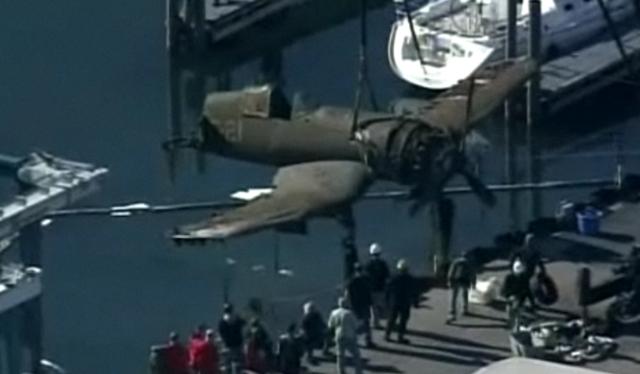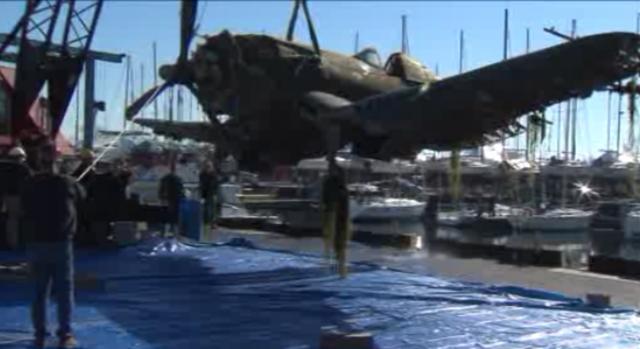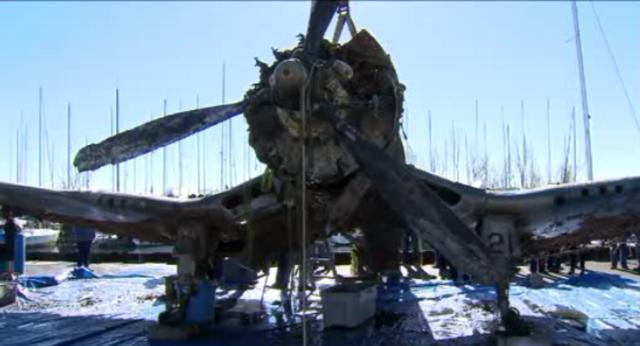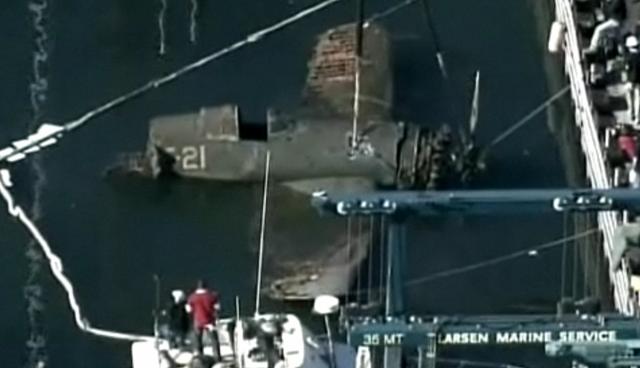November 09, 2010
Warbird Up
In the comments of my post on the paddlewheel aircraft carrier Wolverine, reader The Old Man asked "How many WW2 carrier training birds are on the bottom of the Great Lakes and perhaps could be salvaged?"
Well, as of Monday afternoon the answer is "one fewer," as salvers brought up a doozie.

It's a Corsair, but not just any Corsair. That right there is the world's only known surviving F4U-1, the first marque of the bent-wing bird. It was sometimes known as a "Birdcage Corsair" for the latticework framing of the cockpit.

On June 12th, 1943, Ensign CH Johnson tried to land F-21 on the deck of the Wolverine. Losing sight of the LSO on approach, a common enough occurrence for the long-nosed Corsair, Ensign Johnson took a wave-off and, applying power, began to peel off to the left. Unfortunately, he had settled enough that his tailhook caught a wire, slamming the plane down onto the deck hard enough to split the rear fuselage from the rest of the Corsair. The tailhook assembly was ripped free of the plane as well. Both chunks of the F4U fell overboard and sank, though the front section stayed afloat long enough for Ensign Johnson to escape without harm.

The plane is in remarkably good shape for having been submerged in Lake Michigan for 67 years. The underside is coated with zebra mussels, a common enough problem in the Great Lakes these days. There is rust, of course, but the structure of the Corsair is wholly intact. Indeed, the salvers brought up both pieces of the plane. The only bit missing? The tailhook assembly. Eventually, the F4U-1 is destined for the National Navy Aviation Museum in Pensacola, FL.

The salvage company that performed the rescue, A&T Recovery, says that there's at least 80 more warbirds sitting on the bottom of Lake Michigan, many of which are within 50 miles of Chicago. Almost all of them are Dauntlesses and Wildcats of various types. The F4U wasn't seen in the air above Lake Michigan, as the Wolverine and Sable were really not big enough to handle them comfortably. It may have been there as part of an attempt to requalify the Corsair for carrier operations, as the type had already been limited to ground-based squadrons in late 1942.
While Ensign Johnson got away unharmed from this crash, he wasn't so lucky later. He was killed in a midair collision over Hawaii on Thanksgiving Day, 1943.
Comments are disabled.
Post is locked.
Well, as of Monday afternoon the answer is "one fewer," as salvers brought up a doozie.

It's a Corsair, but not just any Corsair. That right there is the world's only known surviving F4U-1, the first marque of the bent-wing bird. It was sometimes known as a "Birdcage Corsair" for the latticework framing of the cockpit.

On June 12th, 1943, Ensign CH Johnson tried to land F-21 on the deck of the Wolverine. Losing sight of the LSO on approach, a common enough occurrence for the long-nosed Corsair, Ensign Johnson took a wave-off and, applying power, began to peel off to the left. Unfortunately, he had settled enough that his tailhook caught a wire, slamming the plane down onto the deck hard enough to split the rear fuselage from the rest of the Corsair. The tailhook assembly was ripped free of the plane as well. Both chunks of the F4U fell overboard and sank, though the front section stayed afloat long enough for Ensign Johnson to escape without harm.

The plane is in remarkably good shape for having been submerged in Lake Michigan for 67 years. The underside is coated with zebra mussels, a common enough problem in the Great Lakes these days. There is rust, of course, but the structure of the Corsair is wholly intact. Indeed, the salvers brought up both pieces of the plane. The only bit missing? The tailhook assembly. Eventually, the F4U-1 is destined for the National Navy Aviation Museum in Pensacola, FL.

The salvage company that performed the rescue, A&T Recovery, says that there's at least 80 more warbirds sitting on the bottom of Lake Michigan, many of which are within 50 miles of Chicago. Almost all of them are Dauntlesses and Wildcats of various types. The F4U wasn't seen in the air above Lake Michigan, as the Wolverine and Sable were really not big enough to handle them comfortably. It may have been there as part of an attempt to requalify the Corsair for carrier operations, as the type had already been limited to ground-based squadrons in late 1942.
While Ensign Johnson got away unharmed from this crash, he wasn't so lucky later. He was killed in a midair collision over Hawaii on Thanksgiving Day, 1943.
Posted by: Wonderduck at
10:05 PM
| Comments (6)
| Add Comment
Post contains 411 words, total size 3 kb.
1
Bloody awesome. Remarkable condition for the time spent underwater, but I imagine cold temps at depth had almost everything to do with that.
Posted by: The Old Man at November 10, 2010 12:03 PM (Bhe/R)
2
Cold, no light & no free oxygen work really well to preserve objects in water. Using a dry suit & hel/ox in Lake Superior while diving wreaks demonstrated that.
Posted by: Tony von Krag at November 10, 2010 12:31 PM (VGXAE)
3
Amazing.
I knew the Great Lakes had a number of shipwrecks on their bottom, but I never thought about airplanes.
Interestingly enough, that wreck doesn't appear on Wiki's page of surviving Corsair's...yet. (There are five F4U-1A's listed, but no F4U-1's.)
I knew the Great Lakes had a number of shipwrecks on their bottom, but I never thought about airplanes.
Interestingly enough, that wreck doesn't appear on Wiki's page of surviving Corsair's...yet. (There are five F4U-1A's listed, but no F4U-1's.)
Posted by: karrde at November 10, 2010 08:50 PM (ekCkq)
4
Karrde, I don't think it counts as a survivor yet. I mean, look at it; two pieces, both heavily rusted. It will, eventually, but not yet.
It never will be flyable, by the way. The Naval Aviation Museum is all static displays; they won't restore it all the way, even if it could be.
It never will be flyable, by the way. The Naval Aviation Museum is all static displays; they won't restore it all the way, even if it could be.
Posted by: Wonderduck at November 10, 2010 10:10 PM (vW/MM)
5
A D*** shame that IMO. When I went in the USAF in '67 there were still some WW2 birds flying, making that wonderful noise. As the saying goes "Jet noise, the SOUND of FREEDOM." so to is the beat of a recip on run-up.
Posted by: Tony von Krag at November 11, 2010 09:58 AM (VGXAE)
6
Much better condition than if it had been in warm salt water. I'd read about this on the 'net earlier but it didn't really hit me what the fuss was about until I saw the photo of that three bladed prop. I'm so used to the four "paddle wheels" of the later models. You can actuall read some of the lettering on it and much more of the sheet metal is there than what I'm used to seeing. Some of the local guys who troll the Texas fresh water lakes with magnents say that they've pulled up stuff steel that was rusty but that if it was from deep enough down it was surface rust. A couple have firearms that they restored to working condition. The mineral contents of the lakes cause a variation of course.
Posted by: toadold at November 13, 2010 04:28 PM (qX4Ip)
27kb generated in CPU 0.0187, elapsed 0.4223 seconds.
47 queries taking 0.4147 seconds, 282 records returned.
Powered by Minx 1.1.6c-pink.
47 queries taking 0.4147 seconds, 282 records returned.
Powered by Minx 1.1.6c-pink.









